C5369 Diploma of Logistics Sustainability Report, Semester 2
VerifiedAdded on 2023/06/04
|22
|6064
|352
Report
AI Summary
This report, submitted as part of the C5369 Diploma of Logistics program at RMIT University, presents a comprehensive sustainability policy framework tailored for the Victoria Transport Association. The report addresses key aspects of environmental auditing and the development of sustainable workplace procedures, as outlined in the TLIU5006 and TLIU0001 units. It includes an introduction that defines the scope and objectives of the sustainability policy, identifies key stakeholders, and outlines strategies for minimizing resource use, reducing toxic materials, and employing life cycle management approaches. The report further details sustainability practices related to resource usage, waste management, and the reduction of toxic and hazardous chemicals, along with recommendations for implementation. It also covers OH&S and environmental compliance, as well as equal employment opportunity compliance. The report also provides a plan for policy implementation, including stakeholder engagement, life cycle management, training requirements, and continuous improvement strategies. The report is based on the assignment brief provided and incorporates the required elements of performance and knowledge evidence, demonstrating the student's ability to create a detailed and practical sustainability plan for the logistics industry.
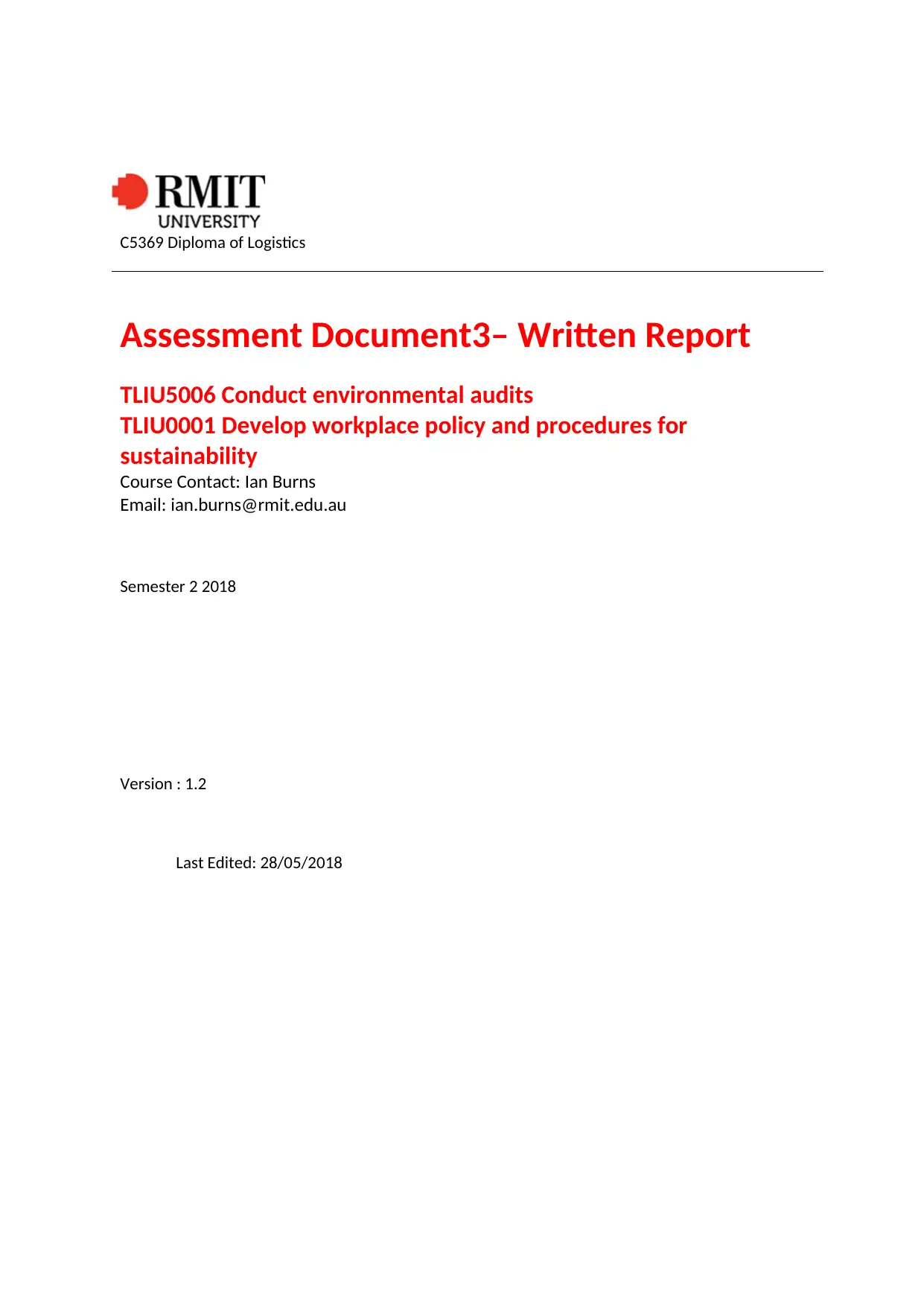
C5369 Diploma of Logistics
Assessment Document3– Written Report
TLIU5006 Conduct environmental audits
TLIU0001 Develop workplace policy and procedures for
sustainability
Course Contact: Ian Burns
Email: ian.burns@rmit.edu.au
Semester 2 2018
Version : 1.2
Last Edited: 28/05/2018
Assessment Document3– Written Report
TLIU5006 Conduct environmental audits
TLIU0001 Develop workplace policy and procedures for
sustainability
Course Contact: Ian Burns
Email: ian.burns@rmit.edu.au
Semester 2 2018
Version : 1.2
Last Edited: 28/05/2018
Paraphrase This Document
Need a fresh take? Get an instant paraphrase of this document with our AI Paraphraser

# Insert your own Title Page
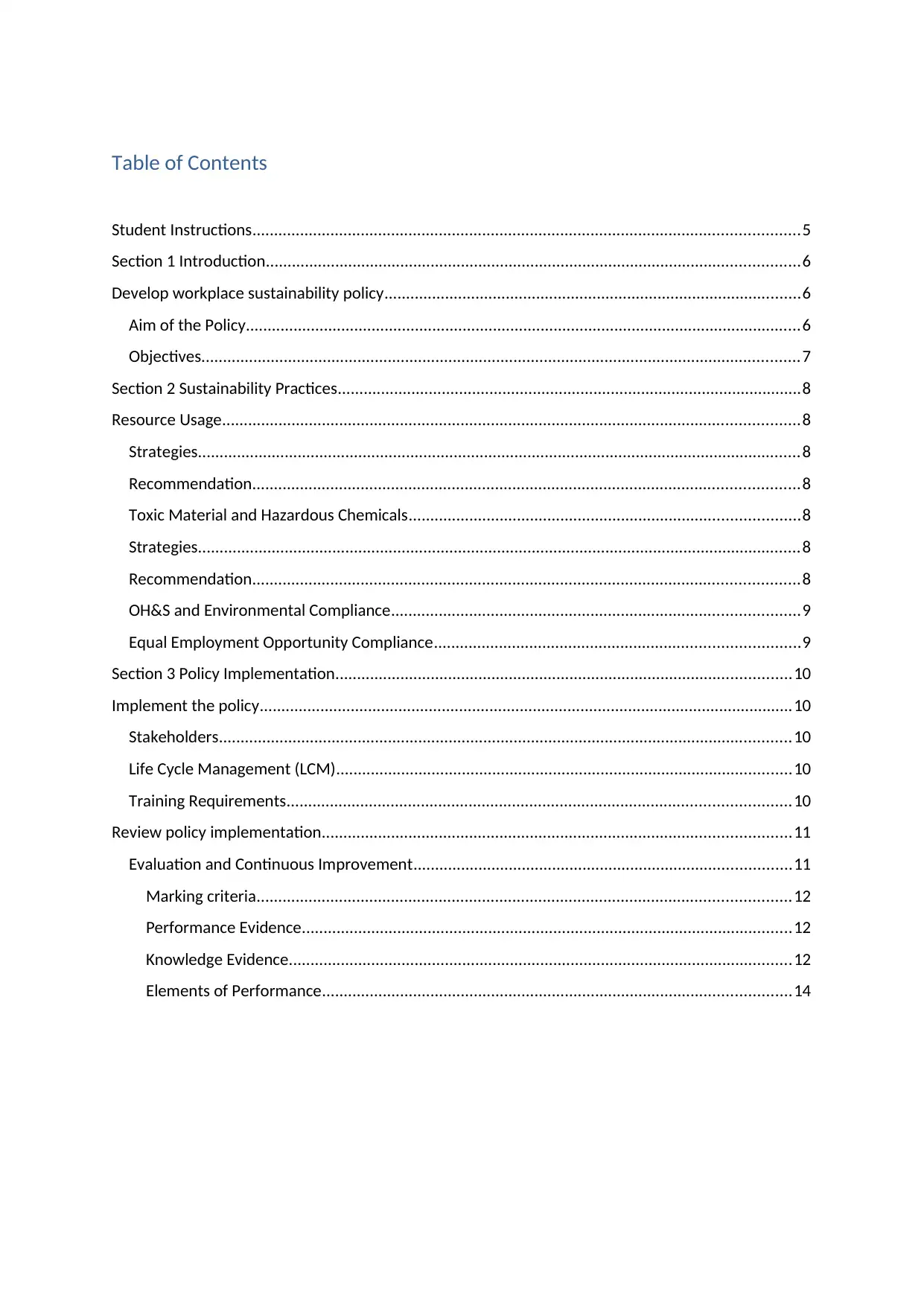
Table of Contents
Student Instructions..............................................................................................................................5
Section 1 Introduction...........................................................................................................................6
Develop workplace sustainability policy................................................................................................6
Aim of the Policy................................................................................................................................6
Objectives..........................................................................................................................................7
Section 2 Sustainability Practices...........................................................................................................8
Resource Usage.....................................................................................................................................8
Strategies...........................................................................................................................................8
Recommendation..............................................................................................................................8
Toxic Material and Hazardous Chemicals..........................................................................................8
Strategies...........................................................................................................................................8
Recommendation..............................................................................................................................8
OH&S and Environmental Compliance..............................................................................................9
Equal Employment Opportunity Compliance....................................................................................9
Section 3 Policy Implementation.........................................................................................................10
Implement the policy...........................................................................................................................10
Stakeholders....................................................................................................................................10
Life Cycle Management (LCM).........................................................................................................10
Training Requirements....................................................................................................................10
Review policy implementation............................................................................................................11
Evaluation and Continuous Improvement.......................................................................................11
Marking criteria...........................................................................................................................12
Performance Evidence.................................................................................................................12
Knowledge Evidence....................................................................................................................12
Elements of Performance............................................................................................................14
Student Instructions..............................................................................................................................5
Section 1 Introduction...........................................................................................................................6
Develop workplace sustainability policy................................................................................................6
Aim of the Policy................................................................................................................................6
Objectives..........................................................................................................................................7
Section 2 Sustainability Practices...........................................................................................................8
Resource Usage.....................................................................................................................................8
Strategies...........................................................................................................................................8
Recommendation..............................................................................................................................8
Toxic Material and Hazardous Chemicals..........................................................................................8
Strategies...........................................................................................................................................8
Recommendation..............................................................................................................................8
OH&S and Environmental Compliance..............................................................................................9
Equal Employment Opportunity Compliance....................................................................................9
Section 3 Policy Implementation.........................................................................................................10
Implement the policy...........................................................................................................................10
Stakeholders....................................................................................................................................10
Life Cycle Management (LCM).........................................................................................................10
Training Requirements....................................................................................................................10
Review policy implementation............................................................................................................11
Evaluation and Continuous Improvement.......................................................................................11
Marking criteria...........................................................................................................................12
Performance Evidence.................................................................................................................12
Knowledge Evidence....................................................................................................................12
Elements of Performance............................................................................................................14
⊘ This is a preview!⊘
Do you want full access?
Subscribe today to unlock all pages.

Trusted by 1+ million students worldwide

Paraphrase This Document
Need a fresh take? Get an instant paraphrase of this document with our AI Paraphraser
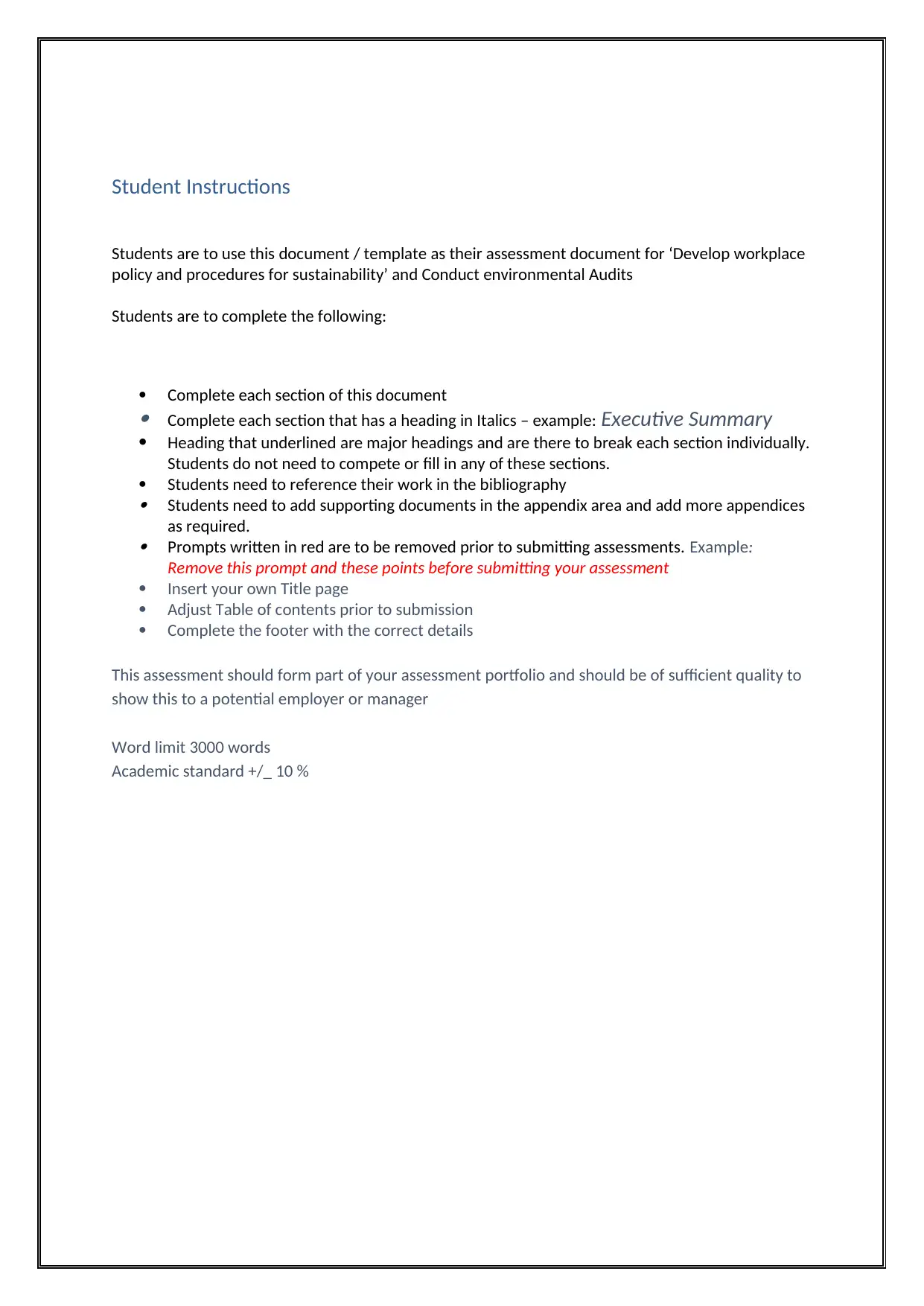
Student Instructions
Students are to use this document / template as their assessment document for ‘Develop workplace
policy and procedures for sustainability’ and Conduct environmental Audits
Students are to complete the following:
Complete each section of this document
Complete each section that has a heading in Italics – example: Executive Summary
Heading that underlined are major headings and are there to break each section individually.
Students do not need to compete or fill in any of these sections.
Students need to reference their work in the bibliography
Students need to add supporting documents in the appendix area and add more appendices
as required.
Prompts written in red are to be removed prior to submitting assessments. Example:
Remove this prompt and these points before submitting your assessment
Insert your own Title page
Adjust Table of contents prior to submission
Complete the footer with the correct details
This assessment should form part of your assessment portfolio and should be of sufficient quality to
show this to a potential employer or manager
Word limit 3000 words
Academic standard +/_ 10 %
Students are to use this document / template as their assessment document for ‘Develop workplace
policy and procedures for sustainability’ and Conduct environmental Audits
Students are to complete the following:
Complete each section of this document
Complete each section that has a heading in Italics – example: Executive Summary
Heading that underlined are major headings and are there to break each section individually.
Students do not need to compete or fill in any of these sections.
Students need to reference their work in the bibliography
Students need to add supporting documents in the appendix area and add more appendices
as required.
Prompts written in red are to be removed prior to submitting assessments. Example:
Remove this prompt and these points before submitting your assessment
Insert your own Title page
Adjust Table of contents prior to submission
Complete the footer with the correct details
This assessment should form part of your assessment portfolio and should be of sufficient quality to
show this to a potential employer or manager
Word limit 3000 words
Academic standard +/_ 10 %
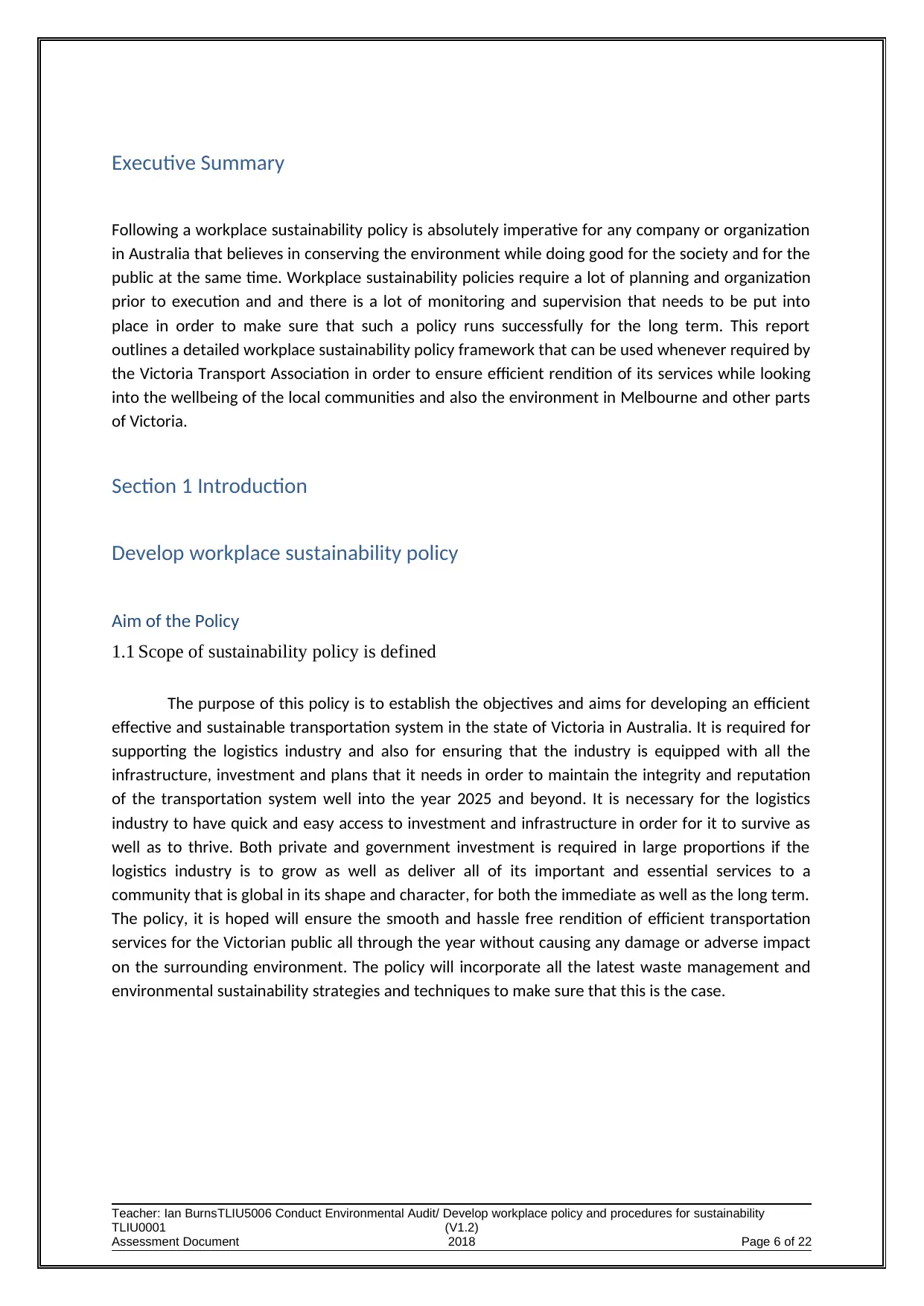
Executive Summary
Following a workplace sustainability policy is absolutely imperative for any company or organization
in Australia that believes in conserving the environment while doing good for the society and for the
public at the same time. Workplace sustainability policies require a lot of planning and organization
prior to execution and and there is a lot of monitoring and supervision that needs to be put into
place in order to make sure that such a policy runs successfully for the long term. This report
outlines a detailed workplace sustainability policy framework that can be used whenever required by
the Victoria Transport Association in order to ensure efficient rendition of its services while looking
into the wellbeing of the local communities and also the environment in Melbourne and other parts
of Victoria.
Section 1 Introduction
Develop workplace sustainability policy
Aim of the Policy
1.1 Scope of sustainability policy is defined
The purpose of this policy is to establish the objectives and aims for developing an efficient
effective and sustainable transportation system in the state of Victoria in Australia. It is required for
supporting the logistics industry and also for ensuring that the industry is equipped with all the
infrastructure, investment and plans that it needs in order to maintain the integrity and reputation
of the transportation system well into the year 2025 and beyond. It is necessary for the logistics
industry to have quick and easy access to investment and infrastructure in order for it to survive as
well as to thrive. Both private and government investment is required in large proportions if the
logistics industry is to grow as well as deliver all of its important and essential services to a
community that is global in its shape and character, for both the immediate as well as the long term.
The policy, it is hoped will ensure the smooth and hassle free rendition of efficient transportation
services for the Victorian public all through the year without causing any damage or adverse impact
on the surrounding environment. The policy will incorporate all the latest waste management and
environmental sustainability strategies and techniques to make sure that this is the case.
Teacher: Ian BurnsTLIU5006 Conduct Environmental Audit/ Develop workplace policy and procedures for sustainability
TLIU0001 (V1.2)
Assessment Document 2018 Page 6 of 22
Following a workplace sustainability policy is absolutely imperative for any company or organization
in Australia that believes in conserving the environment while doing good for the society and for the
public at the same time. Workplace sustainability policies require a lot of planning and organization
prior to execution and and there is a lot of monitoring and supervision that needs to be put into
place in order to make sure that such a policy runs successfully for the long term. This report
outlines a detailed workplace sustainability policy framework that can be used whenever required by
the Victoria Transport Association in order to ensure efficient rendition of its services while looking
into the wellbeing of the local communities and also the environment in Melbourne and other parts
of Victoria.
Section 1 Introduction
Develop workplace sustainability policy
Aim of the Policy
1.1 Scope of sustainability policy is defined
The purpose of this policy is to establish the objectives and aims for developing an efficient
effective and sustainable transportation system in the state of Victoria in Australia. It is required for
supporting the logistics industry and also for ensuring that the industry is equipped with all the
infrastructure, investment and plans that it needs in order to maintain the integrity and reputation
of the transportation system well into the year 2025 and beyond. It is necessary for the logistics
industry to have quick and easy access to investment and infrastructure in order for it to survive as
well as to thrive. Both private and government investment is required in large proportions if the
logistics industry is to grow as well as deliver all of its important and essential services to a
community that is global in its shape and character, for both the immediate as well as the long term.
The policy, it is hoped will ensure the smooth and hassle free rendition of efficient transportation
services for the Victorian public all through the year without causing any damage or adverse impact
on the surrounding environment. The policy will incorporate all the latest waste management and
environmental sustainability strategies and techniques to make sure that this is the case.
Teacher: Ian BurnsTLIU5006 Conduct Environmental Audit/ Develop workplace policy and procedures for sustainability
TLIU0001 (V1.2)
Assessment Document 2018 Page 6 of 22
⊘ This is a preview!⊘
Do you want full access?
Subscribe today to unlock all pages.

Trusted by 1+ million students worldwide
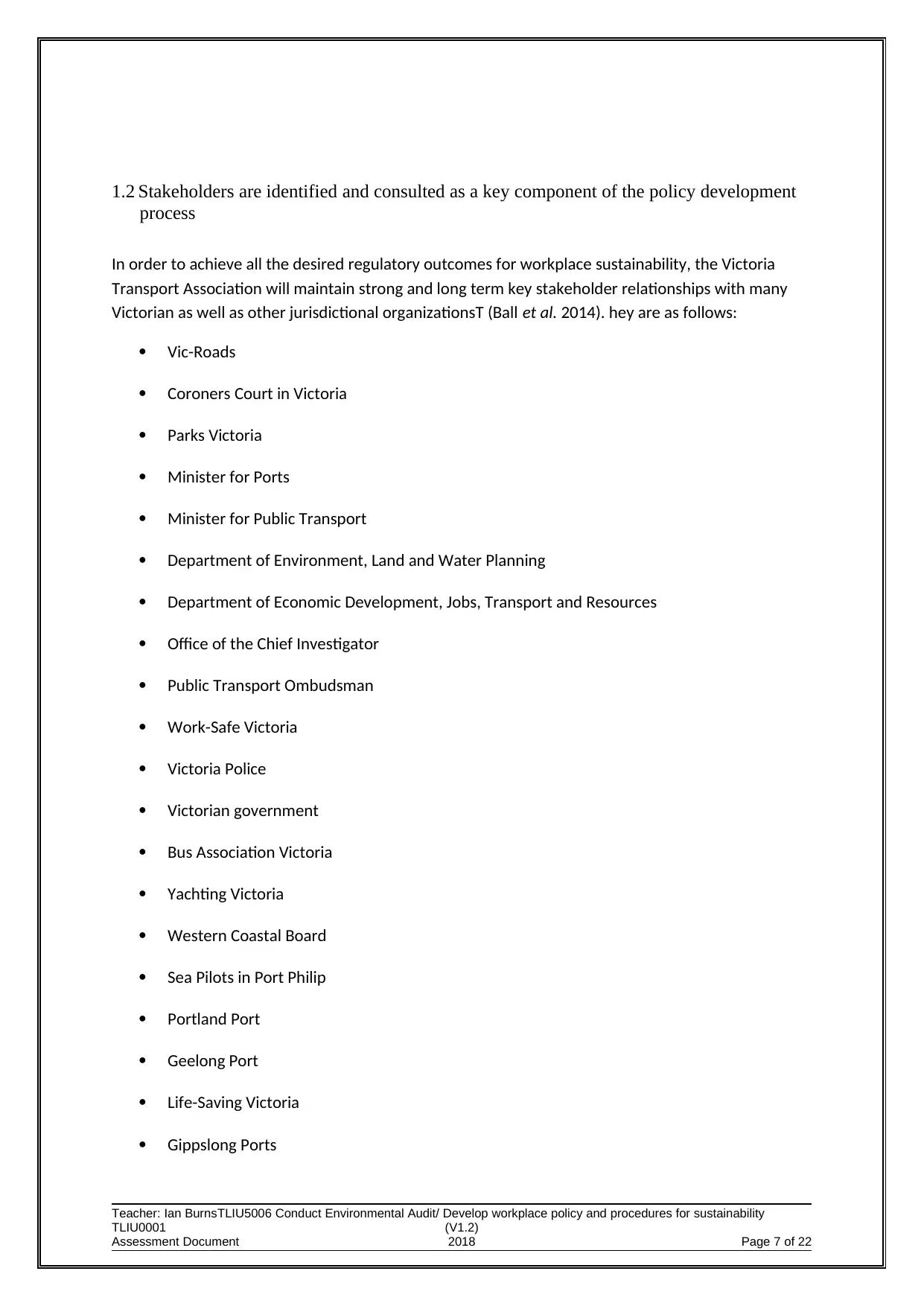
1.2 Stakeholders are identified and consulted as a key component of the policy development
process
In order to achieve all the desired regulatory outcomes for workplace sustainability, the Victoria
Transport Association will maintain strong and long term key stakeholder relationships with many
Victorian as well as other jurisdictional organizationsT (Ball et al. 2014). hey are as follows:
Vic-Roads
Coroners Court in Victoria
Parks Victoria
Minister for Ports
Minister for Public Transport
Department of Environment, Land and Water Planning
Department of Economic Development, Jobs, Transport and Resources
Office of the Chief Investigator
Public Transport Ombudsman
Work-Safe Victoria
Victoria Police
Victorian government
Bus Association Victoria
Yachting Victoria
Western Coastal Board
Sea Pilots in Port Philip
Portland Port
Geelong Port
Life-Saving Victoria
Gippslong Ports
Teacher: Ian BurnsTLIU5006 Conduct Environmental Audit/ Develop workplace policy and procedures for sustainability
TLIU0001 (V1.2)
Assessment Document 2018 Page 7 of 22
process
In order to achieve all the desired regulatory outcomes for workplace sustainability, the Victoria
Transport Association will maintain strong and long term key stakeholder relationships with many
Victorian as well as other jurisdictional organizationsT (Ball et al. 2014). hey are as follows:
Vic-Roads
Coroners Court in Victoria
Parks Victoria
Minister for Ports
Minister for Public Transport
Department of Environment, Land and Water Planning
Department of Economic Development, Jobs, Transport and Resources
Office of the Chief Investigator
Public Transport Ombudsman
Work-Safe Victoria
Victoria Police
Victorian government
Bus Association Victoria
Yachting Victoria
Western Coastal Board
Sea Pilots in Port Philip
Portland Port
Geelong Port
Life-Saving Victoria
Gippslong Ports
Teacher: Ian BurnsTLIU5006 Conduct Environmental Audit/ Develop workplace policy and procedures for sustainability
TLIU0001 (V1.2)
Assessment Document 2018 Page 7 of 22
Paraphrase This Document
Need a fresh take? Get an instant paraphrase of this document with our AI Paraphraser
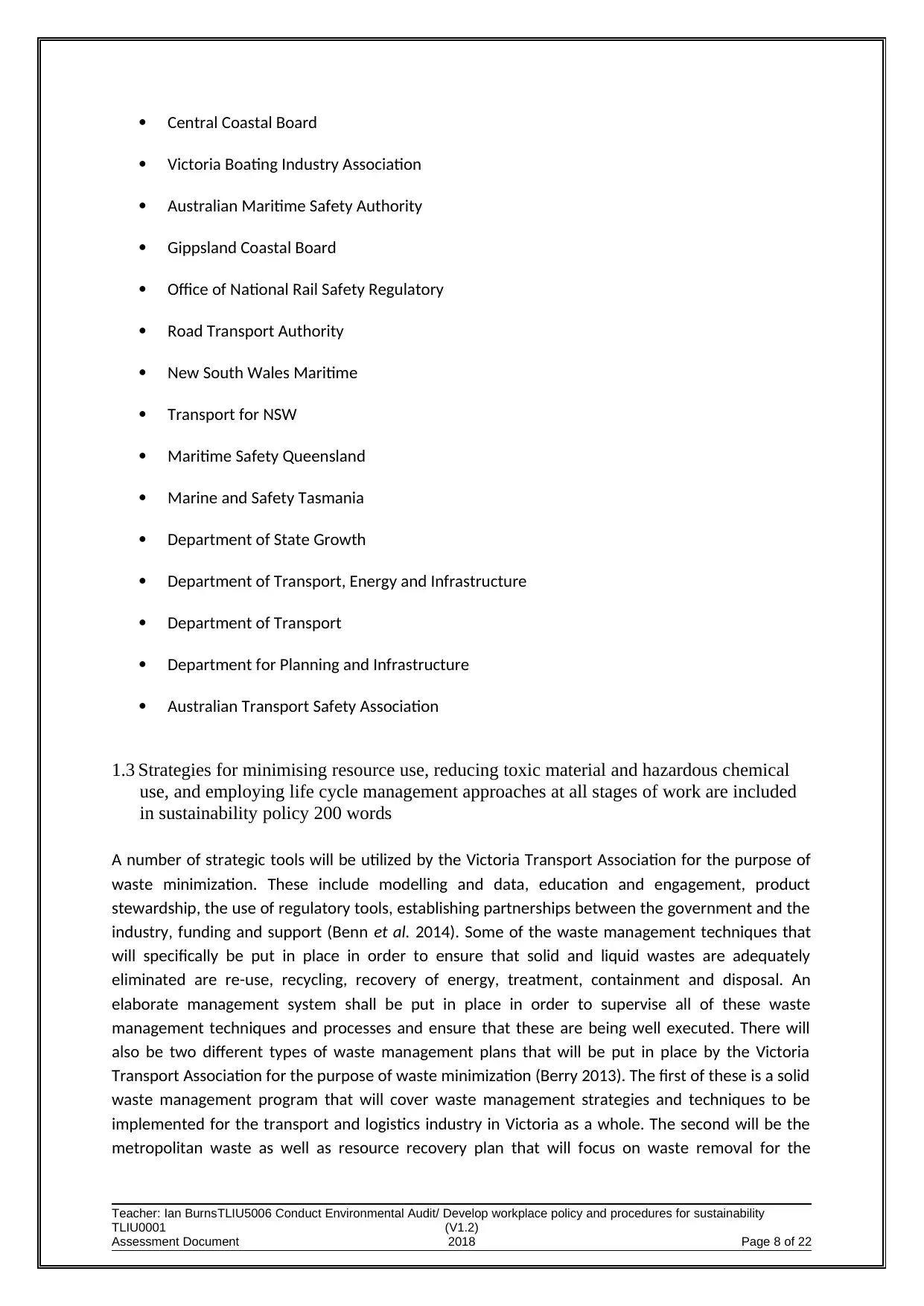
Central Coastal Board
Victoria Boating Industry Association
Australian Maritime Safety Authority
Gippsland Coastal Board
Office of National Rail Safety Regulatory
Road Transport Authority
New South Wales Maritime
Transport for NSW
Maritime Safety Queensland
Marine and Safety Tasmania
Department of State Growth
Department of Transport, Energy and Infrastructure
Department of Transport
Department for Planning and Infrastructure
Australian Transport Safety Association
1.3 Strategies for minimising resource use, reducing toxic material and hazardous chemical
use, and employing life cycle management approaches at all stages of work are included
in sustainability policy 200 words
A number of strategic tools will be utilized by the Victoria Transport Association for the purpose of
waste minimization. These include modelling and data, education and engagement, product
stewardship, the use of regulatory tools, establishing partnerships between the government and the
industry, funding and support (Benn et al. 2014). Some of the waste management techniques that
will specifically be put in place in order to ensure that solid and liquid wastes are adequately
eliminated are re-use, recycling, recovery of energy, treatment, containment and disposal. An
elaborate management system shall be put in place in order to supervise all of these waste
management techniques and processes and ensure that these are being well executed. There will
also be two different types of waste management plans that will be put in place by the Victoria
Transport Association for the purpose of waste minimization (Berry 2013). The first of these is a solid
waste management program that will cover waste management strategies and techniques to be
implemented for the transport and logistics industry in Victoria as a whole. The second will be the
metropolitan waste as well as resource recovery plan that will focus on waste removal for the
Teacher: Ian BurnsTLIU5006 Conduct Environmental Audit/ Develop workplace policy and procedures for sustainability
TLIU0001 (V1.2)
Assessment Document 2018 Page 8 of 22
Victoria Boating Industry Association
Australian Maritime Safety Authority
Gippsland Coastal Board
Office of National Rail Safety Regulatory
Road Transport Authority
New South Wales Maritime
Transport for NSW
Maritime Safety Queensland
Marine and Safety Tasmania
Department of State Growth
Department of Transport, Energy and Infrastructure
Department of Transport
Department for Planning and Infrastructure
Australian Transport Safety Association
1.3 Strategies for minimising resource use, reducing toxic material and hazardous chemical
use, and employing life cycle management approaches at all stages of work are included
in sustainability policy 200 words
A number of strategic tools will be utilized by the Victoria Transport Association for the purpose of
waste minimization. These include modelling and data, education and engagement, product
stewardship, the use of regulatory tools, establishing partnerships between the government and the
industry, funding and support (Benn et al. 2014). Some of the waste management techniques that
will specifically be put in place in order to ensure that solid and liquid wastes are adequately
eliminated are re-use, recycling, recovery of energy, treatment, containment and disposal. An
elaborate management system shall be put in place in order to supervise all of these waste
management techniques and processes and ensure that these are being well executed. There will
also be two different types of waste management plans that will be put in place by the Victoria
Transport Association for the purpose of waste minimization (Berry 2013). The first of these is a solid
waste management program that will cover waste management strategies and techniques to be
implemented for the transport and logistics industry in Victoria as a whole. The second will be the
metropolitan waste as well as resource recovery plan that will focus on waste removal for the
Teacher: Ian BurnsTLIU5006 Conduct Environmental Audit/ Develop workplace policy and procedures for sustainability
TLIU0001 (V1.2)
Assessment Document 2018 Page 8 of 22
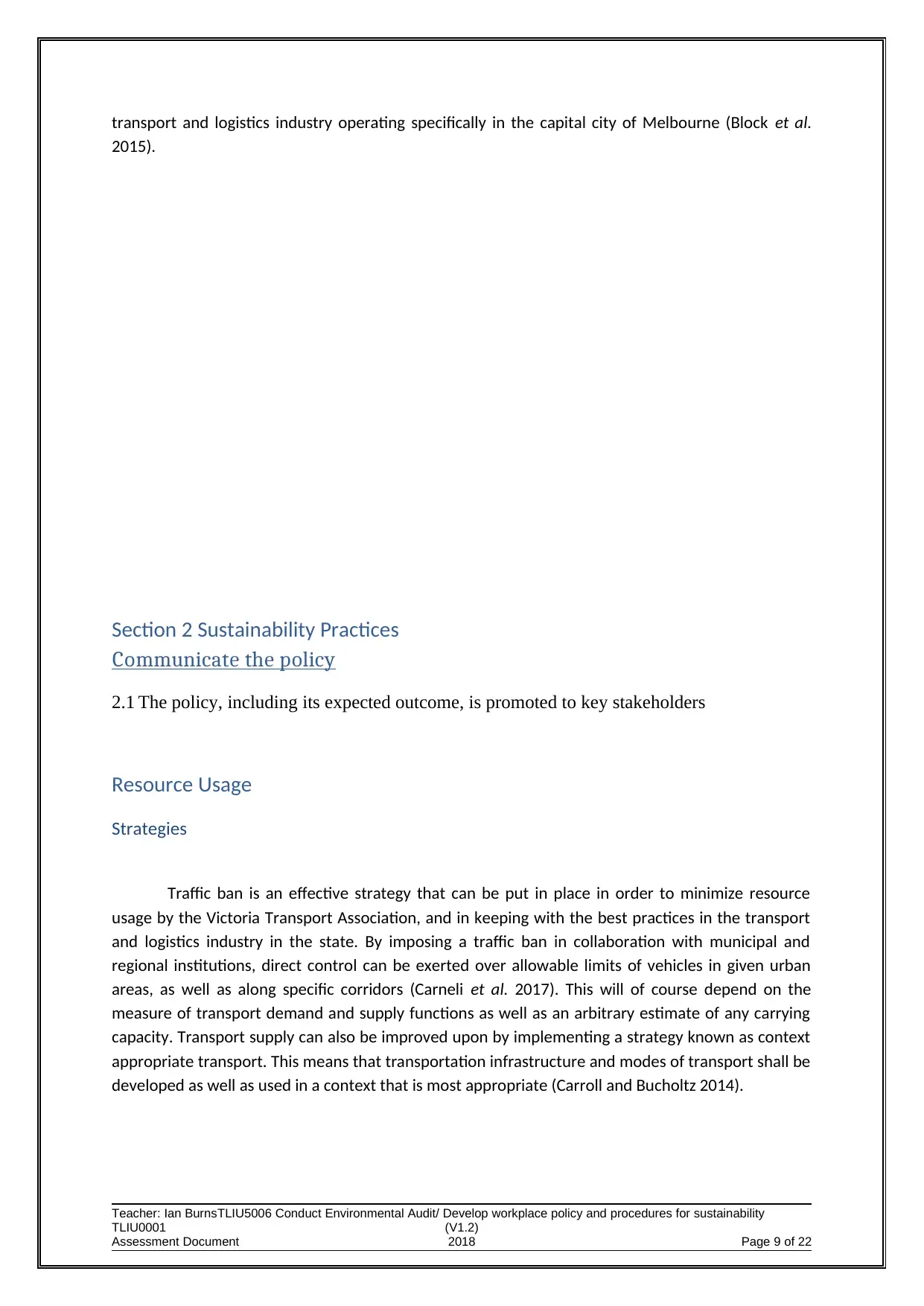
transport and logistics industry operating specifically in the capital city of Melbourne (Block et al.
2015).
Section 2 Sustainability Practices
Communicate the policy
2.1 The policy, including its expected outcome, is promoted to key stakeholders
Resource Usage
Strategies
Traffic ban is an effective strategy that can be put in place in order to minimize resource
usage by the Victoria Transport Association, and in keeping with the best practices in the transport
and logistics industry in the state. By imposing a traffic ban in collaboration with municipal and
regional institutions, direct control can be exerted over allowable limits of vehicles in given urban
areas, as well as along specific corridors (Carneli et al. 2017). This will of course depend on the
measure of transport demand and supply functions as well as an arbitrary estimate of any carrying
capacity. Transport supply can also be improved upon by implementing a strategy known as context
appropriate transport. This means that transportation infrastructure and modes of transport shall be
developed as well as used in a context that is most appropriate (Carroll and Bucholtz 2014).
Teacher: Ian BurnsTLIU5006 Conduct Environmental Audit/ Develop workplace policy and procedures for sustainability
TLIU0001 (V1.2)
Assessment Document 2018 Page 9 of 22
2015).
Section 2 Sustainability Practices
Communicate the policy
2.1 The policy, including its expected outcome, is promoted to key stakeholders
Resource Usage
Strategies
Traffic ban is an effective strategy that can be put in place in order to minimize resource
usage by the Victoria Transport Association, and in keeping with the best practices in the transport
and logistics industry in the state. By imposing a traffic ban in collaboration with municipal and
regional institutions, direct control can be exerted over allowable limits of vehicles in given urban
areas, as well as along specific corridors (Carneli et al. 2017). This will of course depend on the
measure of transport demand and supply functions as well as an arbitrary estimate of any carrying
capacity. Transport supply can also be improved upon by implementing a strategy known as context
appropriate transport. This means that transportation infrastructure and modes of transport shall be
developed as well as used in a context that is most appropriate (Carroll and Bucholtz 2014).
Teacher: Ian BurnsTLIU5006 Conduct Environmental Audit/ Develop workplace policy and procedures for sustainability
TLIU0001 (V1.2)
Assessment Document 2018 Page 9 of 22
⊘ This is a preview!⊘
Do you want full access?
Subscribe today to unlock all pages.

Trusted by 1+ million students worldwide
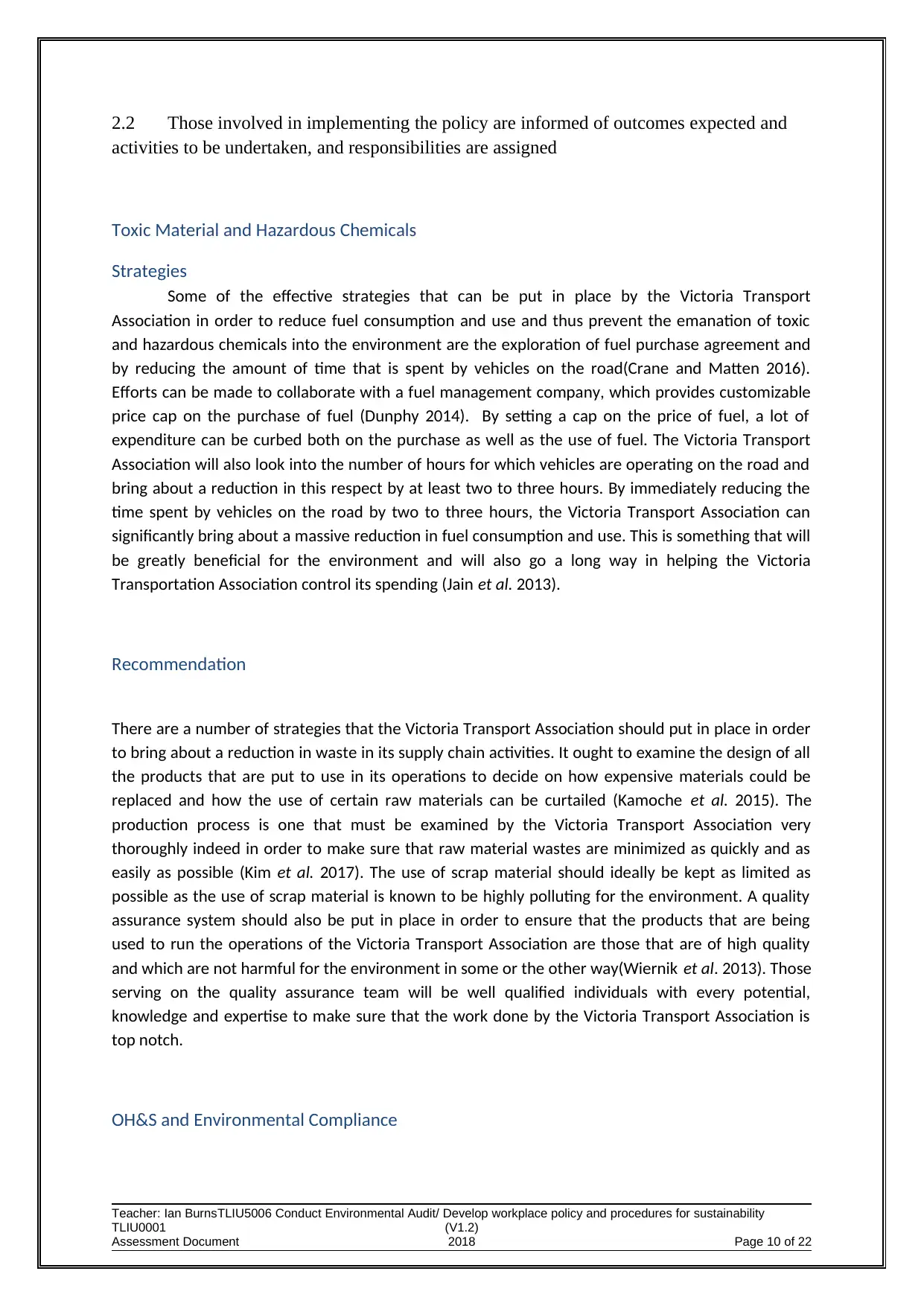
2.2 Those involved in implementing the policy are informed of outcomes expected and
activities to be undertaken, and responsibilities are assigned
Toxic Material and Hazardous Chemicals
Strategies
Some of the effective strategies that can be put in place by the Victoria Transport
Association in order to reduce fuel consumption and use and thus prevent the emanation of toxic
and hazardous chemicals into the environment are the exploration of fuel purchase agreement and
by reducing the amount of time that is spent by vehicles on the road(Crane and Matten 2016).
Efforts can be made to collaborate with a fuel management company, which provides customizable
price cap on the purchase of fuel (Dunphy 2014). By setting a cap on the price of fuel, a lot of
expenditure can be curbed both on the purchase as well as the use of fuel. The Victoria Transport
Association will also look into the number of hours for which vehicles are operating on the road and
bring about a reduction in this respect by at least two to three hours. By immediately reducing the
time spent by vehicles on the road by two to three hours, the Victoria Transport Association can
significantly bring about a massive reduction in fuel consumption and use. This is something that will
be greatly beneficial for the environment and will also go a long way in helping the Victoria
Transportation Association control its spending (Jain et al. 2013).
Recommendation
There are a number of strategies that the Victoria Transport Association should put in place in order
to bring about a reduction in waste in its supply chain activities. It ought to examine the design of all
the products that are put to use in its operations to decide on how expensive materials could be
replaced and how the use of certain raw materials can be curtailed (Kamoche et al. 2015). The
production process is one that must be examined by the Victoria Transport Association very
thoroughly indeed in order to make sure that raw material wastes are minimized as quickly and as
easily as possible (Kim et al. 2017). The use of scrap material should ideally be kept as limited as
possible as the use of scrap material is known to be highly polluting for the environment. A quality
assurance system should also be put in place in order to ensure that the products that are being
used to run the operations of the Victoria Transport Association are those that are of high quality
and which are not harmful for the environment in some or the other way(Wiernik et al. 2013). Those
serving on the quality assurance team will be well qualified individuals with every potential,
knowledge and expertise to make sure that the work done by the Victoria Transport Association is
top notch.
OH&S and Environmental Compliance
Teacher: Ian BurnsTLIU5006 Conduct Environmental Audit/ Develop workplace policy and procedures for sustainability
TLIU0001 (V1.2)
Assessment Document 2018 Page 10 of 22
activities to be undertaken, and responsibilities are assigned
Toxic Material and Hazardous Chemicals
Strategies
Some of the effective strategies that can be put in place by the Victoria Transport
Association in order to reduce fuel consumption and use and thus prevent the emanation of toxic
and hazardous chemicals into the environment are the exploration of fuel purchase agreement and
by reducing the amount of time that is spent by vehicles on the road(Crane and Matten 2016).
Efforts can be made to collaborate with a fuel management company, which provides customizable
price cap on the purchase of fuel (Dunphy 2014). By setting a cap on the price of fuel, a lot of
expenditure can be curbed both on the purchase as well as the use of fuel. The Victoria Transport
Association will also look into the number of hours for which vehicles are operating on the road and
bring about a reduction in this respect by at least two to three hours. By immediately reducing the
time spent by vehicles on the road by two to three hours, the Victoria Transport Association can
significantly bring about a massive reduction in fuel consumption and use. This is something that will
be greatly beneficial for the environment and will also go a long way in helping the Victoria
Transportation Association control its spending (Jain et al. 2013).
Recommendation
There are a number of strategies that the Victoria Transport Association should put in place in order
to bring about a reduction in waste in its supply chain activities. It ought to examine the design of all
the products that are put to use in its operations to decide on how expensive materials could be
replaced and how the use of certain raw materials can be curtailed (Kamoche et al. 2015). The
production process is one that must be examined by the Victoria Transport Association very
thoroughly indeed in order to make sure that raw material wastes are minimized as quickly and as
easily as possible (Kim et al. 2017). The use of scrap material should ideally be kept as limited as
possible as the use of scrap material is known to be highly polluting for the environment. A quality
assurance system should also be put in place in order to ensure that the products that are being
used to run the operations of the Victoria Transport Association are those that are of high quality
and which are not harmful for the environment in some or the other way(Wiernik et al. 2013). Those
serving on the quality assurance team will be well qualified individuals with every potential,
knowledge and expertise to make sure that the work done by the Victoria Transport Association is
top notch.
OH&S and Environmental Compliance
Teacher: Ian BurnsTLIU5006 Conduct Environmental Audit/ Develop workplace policy and procedures for sustainability
TLIU0001 (V1.2)
Assessment Document 2018 Page 10 of 22
Paraphrase This Document
Need a fresh take? Get an instant paraphrase of this document with our AI Paraphraser
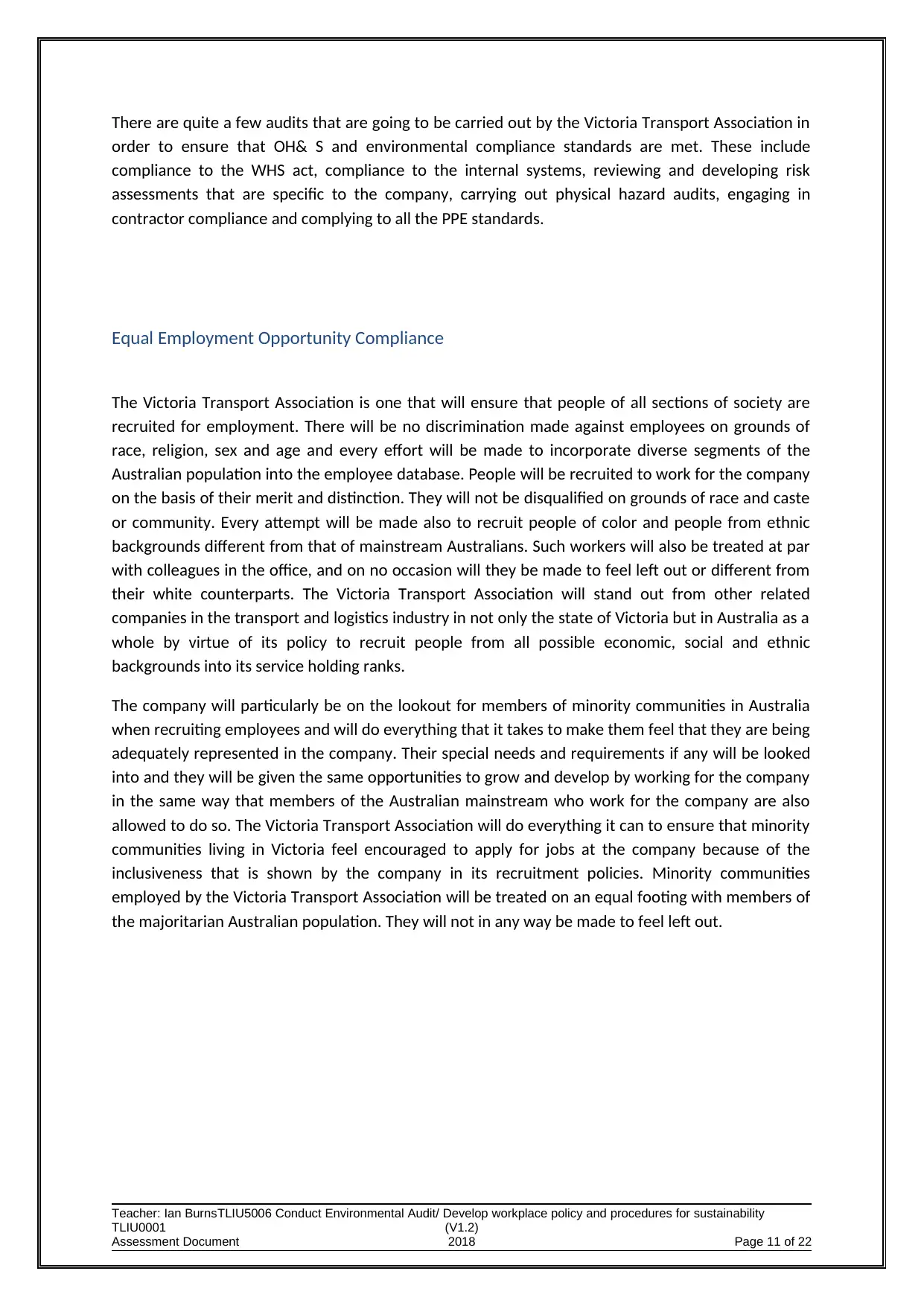
There are quite a few audits that are going to be carried out by the Victoria Transport Association in
order to ensure that OH& S and environmental compliance standards are met. These include
compliance to the WHS act, compliance to the internal systems, reviewing and developing risk
assessments that are specific to the company, carrying out physical hazard audits, engaging in
contractor compliance and complying to all the PPE standards.
Equal Employment Opportunity Compliance
The Victoria Transport Association is one that will ensure that people of all sections of society are
recruited for employment. There will be no discrimination made against employees on grounds of
race, religion, sex and age and every effort will be made to incorporate diverse segments of the
Australian population into the employee database. People will be recruited to work for the company
on the basis of their merit and distinction. They will not be disqualified on grounds of race and caste
or community. Every attempt will be made also to recruit people of color and people from ethnic
backgrounds different from that of mainstream Australians. Such workers will also be treated at par
with colleagues in the office, and on no occasion will they be made to feel left out or different from
their white counterparts. The Victoria Transport Association will stand out from other related
companies in the transport and logistics industry in not only the state of Victoria but in Australia as a
whole by virtue of its policy to recruit people from all possible economic, social and ethnic
backgrounds into its service holding ranks.
The company will particularly be on the lookout for members of minority communities in Australia
when recruiting employees and will do everything that it takes to make them feel that they are being
adequately represented in the company. Their special needs and requirements if any will be looked
into and they will be given the same opportunities to grow and develop by working for the company
in the same way that members of the Australian mainstream who work for the company are also
allowed to do so. The Victoria Transport Association will do everything it can to ensure that minority
communities living in Victoria feel encouraged to apply for jobs at the company because of the
inclusiveness that is shown by the company in its recruitment policies. Minority communities
employed by the Victoria Transport Association will be treated on an equal footing with members of
the majoritarian Australian population. They will not in any way be made to feel left out.
Teacher: Ian BurnsTLIU5006 Conduct Environmental Audit/ Develop workplace policy and procedures for sustainability
TLIU0001 (V1.2)
Assessment Document 2018 Page 11 of 22
order to ensure that OH& S and environmental compliance standards are met. These include
compliance to the WHS act, compliance to the internal systems, reviewing and developing risk
assessments that are specific to the company, carrying out physical hazard audits, engaging in
contractor compliance and complying to all the PPE standards.
Equal Employment Opportunity Compliance
The Victoria Transport Association is one that will ensure that people of all sections of society are
recruited for employment. There will be no discrimination made against employees on grounds of
race, religion, sex and age and every effort will be made to incorporate diverse segments of the
Australian population into the employee database. People will be recruited to work for the company
on the basis of their merit and distinction. They will not be disqualified on grounds of race and caste
or community. Every attempt will be made also to recruit people of color and people from ethnic
backgrounds different from that of mainstream Australians. Such workers will also be treated at par
with colleagues in the office, and on no occasion will they be made to feel left out or different from
their white counterparts. The Victoria Transport Association will stand out from other related
companies in the transport and logistics industry in not only the state of Victoria but in Australia as a
whole by virtue of its policy to recruit people from all possible economic, social and ethnic
backgrounds into its service holding ranks.
The company will particularly be on the lookout for members of minority communities in Australia
when recruiting employees and will do everything that it takes to make them feel that they are being
adequately represented in the company. Their special needs and requirements if any will be looked
into and they will be given the same opportunities to grow and develop by working for the company
in the same way that members of the Australian mainstream who work for the company are also
allowed to do so. The Victoria Transport Association will do everything it can to ensure that minority
communities living in Victoria feel encouraged to apply for jobs at the company because of the
inclusiveness that is shown by the company in its recruitment policies. Minority communities
employed by the Victoria Transport Association will be treated on an equal footing with members of
the majoritarian Australian population. They will not in any way be made to feel left out.
Teacher: Ian BurnsTLIU5006 Conduct Environmental Audit/ Develop workplace policy and procedures for sustainability
TLIU0001 (V1.2)
Assessment Document 2018 Page 11 of 22
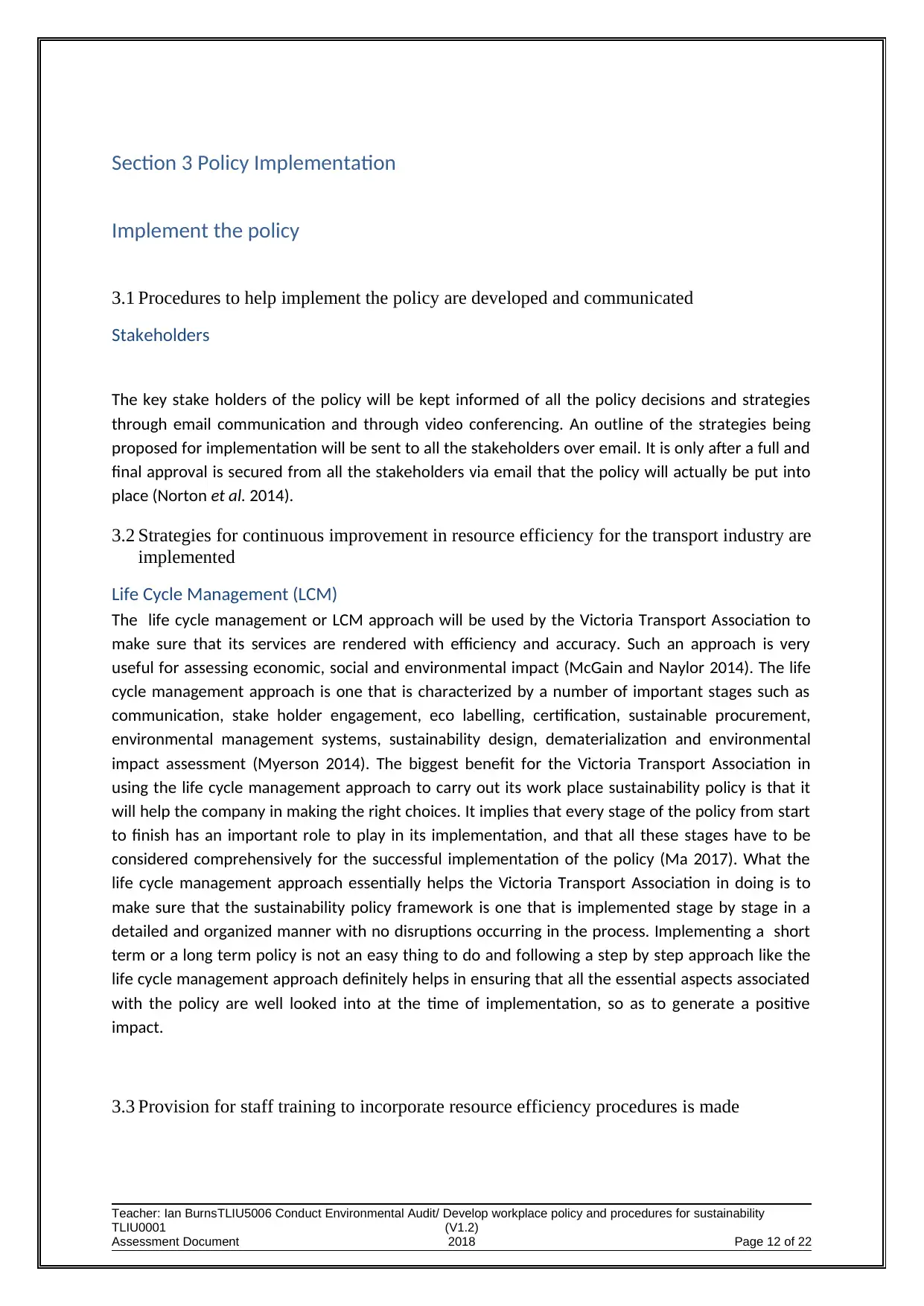
Section 3 Policy Implementation
Implement the policy
3.1 Procedures to help implement the policy are developed and communicated
Stakeholders
The key stake holders of the policy will be kept informed of all the policy decisions and strategies
through email communication and through video conferencing. An outline of the strategies being
proposed for implementation will be sent to all the stakeholders over email. It is only after a full and
final approval is secured from all the stakeholders via email that the policy will actually be put into
place (Norton et al. 2014).
3.2 Strategies for continuous improvement in resource efficiency for the transport industry are
implemented
Life Cycle Management (LCM)
The life cycle management or LCM approach will be used by the Victoria Transport Association to
make sure that its services are rendered with efficiency and accuracy. Such an approach is very
useful for assessing economic, social and environmental impact (McGain and Naylor 2014). The life
cycle management approach is one that is characterized by a number of important stages such as
communication, stake holder engagement, eco labelling, certification, sustainable procurement,
environmental management systems, sustainability design, dematerialization and environmental
impact assessment (Myerson 2014). The biggest benefit for the Victoria Transport Association in
using the life cycle management approach to carry out its work place sustainability policy is that it
will help the company in making the right choices. It implies that every stage of the policy from start
to finish has an important role to play in its implementation, and that all these stages have to be
considered comprehensively for the successful implementation of the policy (Ma 2017). What the
life cycle management approach essentially helps the Victoria Transport Association in doing is to
make sure that the sustainability policy framework is one that is implemented stage by stage in a
detailed and organized manner with no disruptions occurring in the process. Implementing a short
term or a long term policy is not an easy thing to do and following a step by step approach like the
life cycle management approach definitely helps in ensuring that all the essential aspects associated
with the policy are well looked into at the time of implementation, so as to generate a positive
impact.
3.3 Provision for staff training to incorporate resource efficiency procedures is made
Teacher: Ian BurnsTLIU5006 Conduct Environmental Audit/ Develop workplace policy and procedures for sustainability
TLIU0001 (V1.2)
Assessment Document 2018 Page 12 of 22
Implement the policy
3.1 Procedures to help implement the policy are developed and communicated
Stakeholders
The key stake holders of the policy will be kept informed of all the policy decisions and strategies
through email communication and through video conferencing. An outline of the strategies being
proposed for implementation will be sent to all the stakeholders over email. It is only after a full and
final approval is secured from all the stakeholders via email that the policy will actually be put into
place (Norton et al. 2014).
3.2 Strategies for continuous improvement in resource efficiency for the transport industry are
implemented
Life Cycle Management (LCM)
The life cycle management or LCM approach will be used by the Victoria Transport Association to
make sure that its services are rendered with efficiency and accuracy. Such an approach is very
useful for assessing economic, social and environmental impact (McGain and Naylor 2014). The life
cycle management approach is one that is characterized by a number of important stages such as
communication, stake holder engagement, eco labelling, certification, sustainable procurement,
environmental management systems, sustainability design, dematerialization and environmental
impact assessment (Myerson 2014). The biggest benefit for the Victoria Transport Association in
using the life cycle management approach to carry out its work place sustainability policy is that it
will help the company in making the right choices. It implies that every stage of the policy from start
to finish has an important role to play in its implementation, and that all these stages have to be
considered comprehensively for the successful implementation of the policy (Ma 2017). What the
life cycle management approach essentially helps the Victoria Transport Association in doing is to
make sure that the sustainability policy framework is one that is implemented stage by stage in a
detailed and organized manner with no disruptions occurring in the process. Implementing a short
term or a long term policy is not an easy thing to do and following a step by step approach like the
life cycle management approach definitely helps in ensuring that all the essential aspects associated
with the policy are well looked into at the time of implementation, so as to generate a positive
impact.
3.3 Provision for staff training to incorporate resource efficiency procedures is made
Teacher: Ian BurnsTLIU5006 Conduct Environmental Audit/ Develop workplace policy and procedures for sustainability
TLIU0001 (V1.2)
Assessment Document 2018 Page 12 of 22
⊘ This is a preview!⊘
Do you want full access?
Subscribe today to unlock all pages.

Trusted by 1+ million students worldwide
1 out of 22
Related Documents
Your All-in-One AI-Powered Toolkit for Academic Success.
+13062052269
info@desklib.com
Available 24*7 on WhatsApp / Email
![[object Object]](/_next/static/media/star-bottom.7253800d.svg)
Unlock your academic potential
Copyright © 2020–2025 A2Z Services. All Rights Reserved. Developed and managed by ZUCOL.





